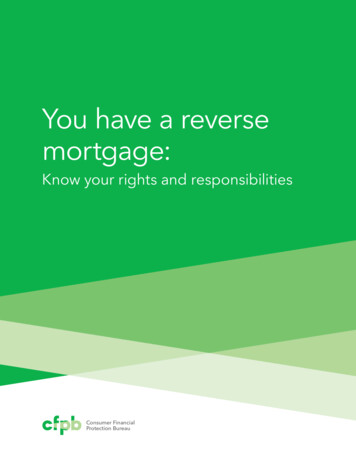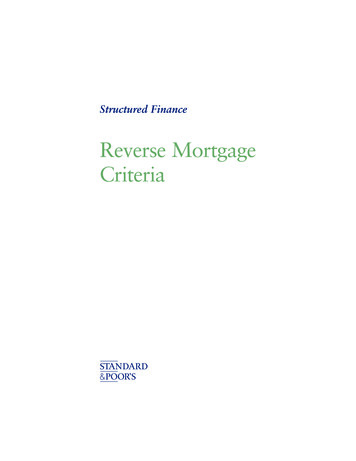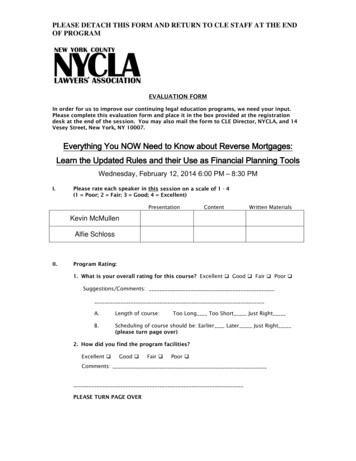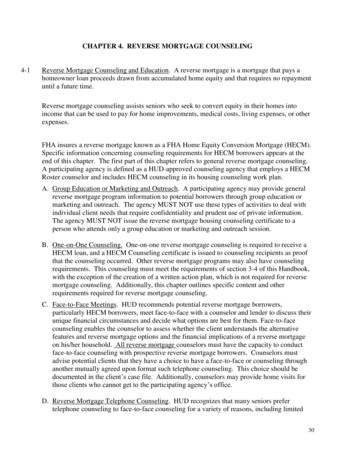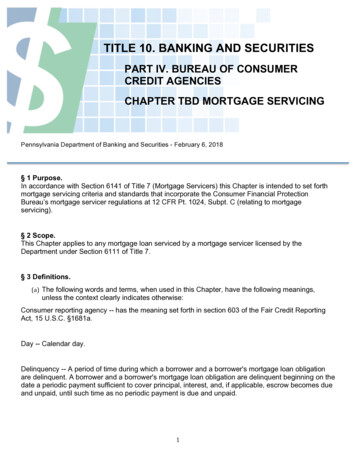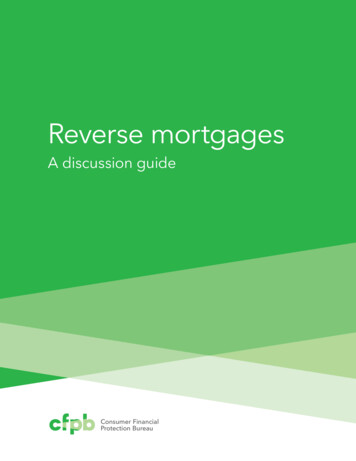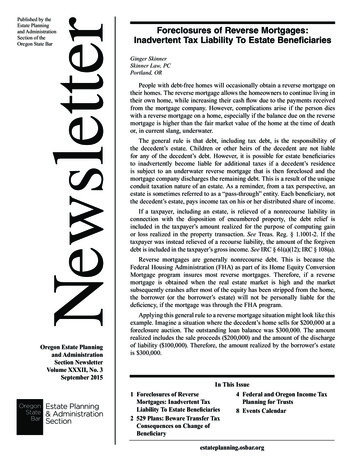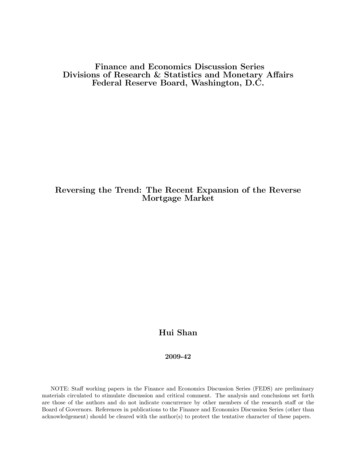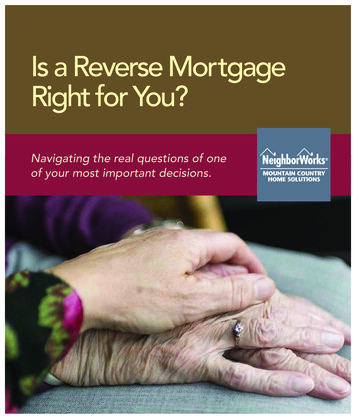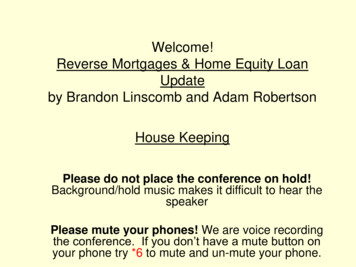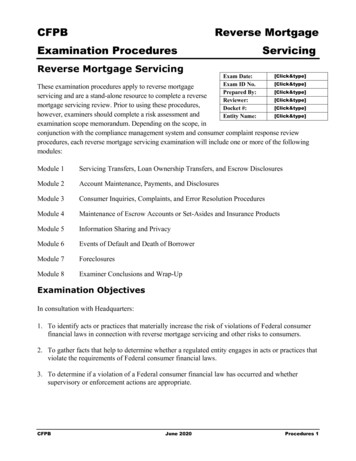
Transcription
CFPBReverse MortgageExamination ProceduresReverse Mortgage ServicingServicingExam Date:Exam ID No.Prepared By:Reviewer:Docket #:Entity Name:[Click&type][Click&type]These examination procedures apply to reverse mortgage[Click&type]servicing and are a stand-alone resource to complete a reverse[Click&type]mortgage servicing review. Prior to using these procedures,[Click&type]however, examiners should complete a risk assessment and[Click&type]examination scope memorandum. Depending on the scope, inconjunction with the compliance management system and consumer complaint response reviewprocedures, each reverse mortgage servicing examination will include one or more of the followingmodules:Module 1Servicing Transfers, Loan Ownership Transfers, and Escrow DisclosuresModule 2Account Maintenance, Payments, and DisclosuresModule 3Consumer Inquiries, Complaints, and Error Resolution ProceduresModule 4Maintenance of Escrow Accounts or Set-Asides and Insurance ProductsModule 5Information Sharing and PrivacyModule 6Events of Default and Death of BorrowerModule 7ForeclosuresModule 8Examiner Conclusions and Wrap-UpExamination ObjectivesIn consultation with Headquarters:1. To identify acts or practices that materially increase the risk of violations of Federal consumerfinancial laws in connection with reverse mortgage servicing and other risks to consumers.2. To gather facts that help to determine whether a regulated entity engages in acts or practices thatviolate the requirements of Federal consumer financial laws.3. To determine if a violation of a Federal consumer financial law has occurred and whethersupervisory or enforcement actions are appropriate.CFPBJune 2020Procedures 1
CFPBReverse MortgageExamination ProceduresServicingBackgroundReverse Mortgage OriginationA reverse mortgage is a special type of loan that allows older homeowners to borrow against theequity (wealth) in their homes. Instead of making payments to the servicer, the borrower receivesfunds from the lender. The borrower may elect to receive the funds as monthly payments, a lump sum,or by accessing a line of credit. These funds, plus the interest charged on the loan, and any fees such asinsurance premiums or servicing fees, increase the balance of the loan each month. Over time, the loanamount grows, and must be re-paid when the borrower dies or a default event occurs. Since equity isthe value of the home minus any loans, the borrower has less and less equity in the home as the loanbalance increases. A borrower may, but is not obligated to, make payments to reduce the loan balance.The Federal Housing Administration (FHA), under the Home Equity Conversion Mortgage (HECM)program, insures most reverse mortgages. As with other FHA insured mortgage products, there is amaximum loan amount. Some lenders also offer proprietary (non-HECM) reverse mortgages, whichgenerally are designed for borrowers with higher home values and more equity to borrow against.These proprietary reverse mortgages are not federally insured, but many companies that offerproprietary reverse mortgages emulate the consumer protections found in the HECM program,including mandatory counseling.Generally, in order to qualify for a HECM reverse mortgage, a borrower must: Be at least 62 years old; Reside in an eligible home as their primary residence;1 and Own the home free and clear, or have substantial equity in the home. Not be delinquent on any federal debt, such as federal income taxes or federal student loans. Theborrower may, however, use funds from the reverse mortgage to pay off this debt; Have a home that is in good condition; and Receive counseling from a U.S. Department of Housing and Urban Development (HUD)approved reverse mortgage counseling agency.Lenders will also conduct a financial assessment to ensure borrowers have the financial capacity tocontinue paying obligations, such as real estate taxes, and homeowner's or flood insurance. The1Eligible property types include single-family homes, 2-4 unit properties, manufactured homes built after June 1976, condominiums,and townhouses. Co-ops do not qualify.CFPBJune 2020Procedures 2
CFPBReverse MortgageExamination ProceduresServicingreverse mortgage also must be in first lien position, so the borrower must first pay any existing liens infull.(1) There are different options for receiving funds from a reverse mortgage loan. With a HECMloan for example, a borrower can receive money as a line of credit; in monthly installments; orin a lump sum.The borrower can also get a combination of monthly installments and a line of credit. There is a capon the amount a borrower can take out in the first year on all HECM payout options. The lender willcalculate the amount that the customer is authorized to borrow overall, based on age, the interest rate,and value of the home. This number is the initial principal limit. Generally, a borrower can take out upto 60 percent of the initial principal limit in the first year. However, if the amount owed on an existingmortgage (or other required payments) is more than 50 percent of the initial principal limit, theborrower can take out enough to pay off the mortgage (and any other required payments, includingupfront loan fees) plus additional cash of up to 10 percent of the initial principal limit. The cost of thisloan product is generally higher than traditional forward mortgage loans. Costs that accrue over timeinclude interest and ongoing mortgage insurance premiums. The interest rate depends on which lenderthe borrower chooses, as well as other factors. The interest rate may be fixed or adjustable. On HECMloans, annual mortgage insurance currently adds an additional 0.5 percent of the outstanding mortgagebalance on top of the interest rate. There are also upfront costs associated with a reverse mortgage.Below is a list of typical fees that lenders may charge at the start of a loan under the HECM program:2 The upfront Mortgage Insurance Premium (MIP) is a one-time, nonrefundable charge currentlyset at 2 percent of the maximum claim amount. An Origination Fee is the amount the lender ormortgage broker charges the borrower for making the reverse mortgage loan. On HECM loans,lenders may currently charge an origination fee of up to 6,000, depending on the maximumclaim amount. Real Estate Settlement Costs (closing costs) are similar to the costs a borrower pays to take out atraditional mortgage. They include appraisal, title insurance, and inspection fees. Reverse Mortgage Counseling Costs are the costs charged by a counseling agency for providingpre-loan counseling required of a HECM loan. HUD rules prohibit a lender from paying thecounseling fee. Although not required, most companies that offer proprietary reverse mortgagesemulate the mandatory counseling requirement found in the HECM program.Many borrowers use a portion of their loan funds to pay for the upfront costs. Paying for upfront costswith loan funds is more expensive than paying for them out of pocket because the borrower will be2There are other upfront requirements for taking out a reverse mortgage, which may include income and asset verification, repair setasides, paying off prior liens, or paying off delinquent federal debt.CFPBJune 2020Procedures 3
CFPBReverse MortgageExamination ProceduresServicingcharged interest and ongoing mortgage insurance on these costs.Reverse Mortgage ServicingAlthough borrowers do not make monthly payments, servicers calculate monthly interest andmortgage insurance charges based on the current loan balance and then add these charges, along withmonthly servicing fees, if applicable, to the loan balance. The amount paid in interest and mortgageinsurance compounds the same way a balance on a credit card does. The loan balance used to calculateinterest and mortgage insurance changes each month and includes the prior month’s interest, mortgageinsurance, and servicing fee charges. As the loan balance grows, the amount of the interest andmortgage insurance charged that month also grows.Taxes, Insurance, and MaintenanceReverse mortgage borrowers are obligated to pay taxes and insurance and to provide normalmaintenance and upkeep of the property for the life of the loan. If taxes and insurance are not paid, orif the borrower allows the condition of the property to deteriorate without making the necessaryrepairs, the lender may consider the borrower to be in default on the loan and the servicer couldforeclose on the home.For many borrowers, payment of taxes and insurance from the reverse mortgage proceeds is easier andmay help prevent default. For some borrowers a written understanding with the servicer for thepayment of taxes and insurance, typically referred to as a set-aside, may even be required. Forexample, under the FHA’s HECM program, at origination, the lender will determine if a LifeExpectancy Set-Aside (LESA) is required, and if so, whether it must be fully funded or partiallyfunded, based on a financial assessment of the borrower. If required, the lender will then create a taxand insurance set-aside.3 This will reduce the principal draw amount available to the borrower.3For a Home Equity Conversion Mortgage (HECM) loan, a set-aside itself is not an escrow account as defined in 12 CFR 1024.17(b).CFPBJune 2020Procedures 4
CFPBReverse MortgageExamination ProceduresServicingOccupancyThe following occupancy requirements apply to HECM reverse mortgage loans: The property must be occupied by the borrower, co-borrower, or eligible non-borrowing spouse4as a principal residence.5 The loan becomes due if the borrower and any co-borrower(s) transfer title. The borrower or, where applicable, the eligible non-borrowing spouse, must complete an annualoccupancy certification.Causes of DefaultA borrower with a reverse mortgage loan may continue to reside in the property for life even if thetotal principal and interest due exceeds the initial principal amount and/or the value of the property.Principal and interest will continue to accrue through the duration of the loan, but no repayment is dueunless one of the following default events occurs: The last borrower on the note dies, or if there is an eligible non-borrowing spouse on a HECMloan originated on or after August 4, 2014, the deferral period after the last borrower’s deathends;6 The borrower and, where applicable, an eligible non-borrowing spouse or the co-borrowers, nolonger occupy the property or fail to certify occupancy; The borrower and any co-borrower transfer ownership; The borrower fails to comply with a requirement of the mortgage, such as if the borrower fails topay taxes or insurance or commits waste.Upon the borrower’s death, the non-borrowing spouse may stay in the home if they pay off the loan.They may also be able to stay in the home depending on when the loan was taken out and whetherthey qualify under HUD’s rules. For loans with case numbers assigned on or after August 4, 2014,4This applies generally to HECM reverse mortgages originated on or after August 4, 2014. The Federal Housing Administration(FHA) defines an eligible non-borrowing spouse to mean the spouse, as determined by the law of the state in which the spouse andmortgagor reside or the state of celebration, of the HECM mortgagor at the time of closing and who also is not a mortgagor; and who1) has been the spouse of the mortgagor at the time of loan closing and has remained the spouse of such HECM mortgagor for theduration of the HECM mortgagor’s lifetime; 2) has been properly disclosed to the mortgagee at origination and specifically named asa Non-Borrowing Spouse in the HECM documents; and 3) has occupied, and continues to occupy, the property securing the HECMas the Principal Residence of the Non-Borrowing Spouse.5A HECM borrower must occupy the subject property as their principal place of residence. The 12 consecutive month exceptionapplies only to borrowers who fail to occupy the subject property because of a physical or mental illness.6 HUD Mortgagee Letter 2014-07 stipulates on HECM loans originated on or after August 4, 2014, that the due and payable statusthat occurs because of the death of the last surviving borrower is deferred until the death of the last surviving non-borrowing spouse;or until another listed event occurs, if a borrower was married at the time of closing and the non-borrowing spouse was identified atthe time of closing and has occupied and continues to occupy the property as the non-borrowing spouse’s principal residence.CFPBJune 2020Procedures 5
CFPBReverse MortgageExamination ProceduresServicingthe servicer will determine if the non-borrowing spouse qualifies for a deferral of the due andpayable status. If the spouse meets certain conditions set by HUD, the non-borrowing spouse will beable to stay in the home.7 For loans with case numbers assigned before August 4, 2014, the servicerafter the death of the borrower may either foreclose on the property8 or may allow the nonborrowing spouse to stay in the home through a process called “Mortgagee Optional Election(MOE) Assignment.”9Some loss mitigation options may also be available if a loan default is due to non-payment of taxes orinsurance, or maintaining the property in good condition. These may include short sale, deed-in-lieuof foreclosure; a repayment plan of advances for taxes or insurance made by the servicer;10, an atrisk extension, or a refinance into another reverse mortgage.The borrower may have the right to sell or refinance. The borrower may sell the property for the lesserof the appraised value or the mortgage balance.11 A HECM borrower is not liable for the difference ifthe loan balance is greater than the property value. The borrower may refinance the property by payingoff the total loan balance. If the property value exceeds the loan balance (including any costs of sale),the borrower is entitled to the difference, after the sale.With respect to a HECM loan, if the cause of default is death of the last borrower, any successors haveup to six months from the date of death to sell or refinance the property and may pay off the loan for95 percent of the appraised value. If the successors sell the home, they are not liable for the differenceif the loan balance is greater than the net proceeds from sale, and they retain all sale proceeds in excess7 To qualify for the deferral period the non-borrowing spouse must: (1) establish within 90 days of borrower’s death their ownershipinterest to the property or a legal right to remain in the home for life; (2) have been married to the borrower at the time the loandocuments were signed up until the borrower’s death (for couples who were unable to be legally married based on gender at the timethe reverse mortgage loan was made, they must show that they were legally married by the time of the borrower’s death); (3) havebeen identified in the loan documents as a non-borrowing spouse; (4) have lived, and continues to live, in the home as their principalresidence; and (5) continue to meet the loan requirements and make sure the loan does not become due and payable for any otherreason.8Ifthe servicer decides to foreclose on the home or finds that the non-borrowing spouse does not qualify for MOE Assignment, theymust begin foreclosure proceedings within six months of the borrower’s death. If the non-borrowing spouse is actively trying to sellthe property or satisfy the debt in some other way, they may request a delay with the foreclosure for up to a 180 days.9To qualify for MOE Assignment the non-borrowing spouse must: (1) have been married to the borrower at the time the loandocuments were signed up until the borrower’s death (for couples who were unable to be legally married based on gender at the timethe reverse mortgage loan was taken out, they must show that they were legally married by the time of the borrower’s death); (2) havelived since the beginning of the loan, and continues to live, in the home as their principal residence; (3) provide their Social Securitynumber or Tax Identification Number; (4) agree that they will no longer receive any payments from the reverse mortgage loan; (5)continue to meet all loan obligations, including paying property taxes and homeowners insurance. See Mortgagee Letter 2019-15.10For HECM loans, HUD issued mortgagee letters 2015-11 and 2016-07 with guidance for establishing repayment plans in the eventa servicer chooses to offer such plans. The servicer will set up a repayment plan with the borrower to repay advanced funds fordefaulted real estate taxes and/or insurance. Use of repayment plans are at the servicer’s discretion.11 For HECM loans that are due and payable, a borrower or an eligible non-borrowing spouse may sell for the lesser of the mortgagebalance or five percent below the appraised value.CFPBJune 2020Procedures 6
CFPBReverse MortgageExamination ProceduresServicingof the loan balance.Applicable LawThe following Federal consumer financial laws and regulations apply to reverse mortgage servicing: The Real Estate Settlement Procedures Act (RESPA) and its implementing regulation,Regulation X, impose requirements for servicing transfers, responding to written informationrequests, resolution of notices of error, force-placed insurance, and escrow accountmaintenance.12 The Truth in Lending Act (TILA) and its implementing regulation, Regulation Z, imposerequirements on servicers regarding payment crediting, including imposition of late fee anddelinquency charges, provision of payoff statements with respect to closed-end consumer credittransactions secured by a principal dwelling, and disclosures regarding rate changes foradjustable rate mortgages. For open-end mortgages, Regulation Z provisions related to errorresolution apply to the extent that the servicer is a creditor. Additionally, TILA and Regulation Zgenerally impose requirements on loan owners for loan ownership transfers.13 The Fair Debt Collection Practices Act (FDCPA) governs collection activities conducted bythird-party collection agencies, as well as servicer collection activities if the servicer is a debtcollector as defined by the FDCPA. Typically, a servicer who acquired the loan when it wasalready in default falls under that definition, but a servicer may not be covered if one of theexceptions to the FDCPA applies. The Gramm-Leach-Bliley Act (GLBA) requires servicers within the scope of coverage toprovide privacy notices and limit information sharing in particular ways. The Equal Credit Opportunity Act (ECOA) and its implementing regulation, Regulation B,apply to those servicers that are creditors, such as those who participate in a credit decision. Thestatute makes it unlawful to discriminate against any borrower with respect to any aspect of acredit transaction:a. On the basis of race, color, religion, national origin, sex or marital status, or age(provided the applicant has the capacity to contract);12However, the general servicing requirements regarding policies and procedures; early intervention; continuity of contact; and lossmitigation procedures of Regulation X are generally inapplicable to servicers of reverse mortgage transactions. 12 CFR1024.30(b)(2). Also, as noted, for a HECM loan, a set-aside itself is not an escrow account as defined in 12 CFR 1024.17(b).13 The periodic statement requirements of Regulation Z are inapplicable to servicers of reverse mortgage transactions. 12 CFR1026.41(e)(1). However, under HUD regulations, the “mortgagee shall provide to the borrower a monthly statement regarding theactivity of the mortgage for each month, as well as for the calendar year.” The statement must summarize the total principal amountpaid to the borrower during that calendar year, the mortgage insurance premiums charged to the borrower and paid to the FHA, thetotal amount of deferred interest added to the outstanding loan balance, the total outstanding loan balance, the current principal limit,and an accounting of all payments for property charges. 24 CFR 206.203(a).CFPBJune 2020Procedures 7
CFPBReverse MortgageExamination ProceduresServicingb. Because all or part of the applicant’s income derives from any public assistance program;orc. Because the applicant has in good faith exercised any right under the Consumer CreditProtection Act.14To carry out the objectives set forth in the Examination Objectives section, the examinationprocess also will include assessing other risks to consumers generally governed by the Dodd-FrankAct. These risks may include potentially unfair, deceptive, or abusive acts or practices (UDAAPs)with respect to servicers’ interactions with consumers.15 Collecting information about risks toconsumers, whether or not there are specific legal guidelines addressing such risks, can help informthe Bureau’s policymaking. The standards the CFPB will use in assessing UDAAPs are:o An act or practice is unfair when:1) It causes or is likely to cause substantial injury to consumers;2) The injury is not reasonably avoidable by consumers; and3) The injury is not outweighed by countervailing benefits to consumers or to competition.oA representation, omission, act, or practice is deceptive when:1) The representation, omission, act, or practice misleads or is likely to mislead theconsumer;2) The consumer’s interpretation of the representation, omission, act, or practice isreasonable under the circumstances; and3) The misleading representation, omission, act, or practice is material.o An abusive act or practice:1) Materially interferes with the ability of a consumer to understand a term or condition of aconsumer financial product or service or2) Takes unreasonable advantage of –14The Consumer Credit Protection Act (the Act), 15 USC 1601 et seq., is the collection of federal statutes that protects consumerswhen applying for or receiving credit. The Act includes statutes that have dispute rights for consumers, such as the Fair CreditReporting Act (FCRA). The Equal Credit Opportunity Act (ECOA) prohibits discriminating against an applicant who has exercised adispute right pursuant to one of the statutes outlined in the Act.15Dodd-Frank Act, Sec. 1036, PL 111-203 (July 21, 2010).CFPBJune 2020Procedures 8
CFPBReverse MortgageExamination ProceduresServicing A lack of understanding on the part of the consumer of the material risks, costs, orconditions of the product or service; The inability of the consumer to protect its interests in selecting or using a consumerfinancial product or service; or The reasonable reliance by the consumer on a covered person to act in the interests ofthe consumer.Please refer to the examination procedures regarding UDAAPs for more information about the legalstandards and the CFPB’s approach to examining for UDAAPs.The particular facts in a case are crucial to a determination of unfair, deceptive, or abusive acts orpractices. As set out in the Examination Objectives section, examiners should consult withHeadquarters to determine whether the applicable legal standards have been met before concludinga violation of any Federal consumer financial law could be cited, including a UDAAP violation.CFPBJune 2020Procedures 9
CFPBReverse MortgageExamination ProceduresServicingReverse Mortgage Servicing Examination ProceduresCompliance Management SystemReview the entity’s compliance management system using the Compliance Management Reviewsection of the CFPB examination procedures.[Click&type]Service Provider OversightReverse mortgage servicers may be responsible for the activities of service providers. Examinersshould ensure that such entities appropriately manage their relationships with service providers.Examiners should evaluate policies, procedures, complaints, and copies of any agreementsbetween entities and service providers acting on behalf of the entity for purposes of assessingrisks to consumers.[Click&type]CFPBJune 2020Procedures 10
CFPBReverse Mortgage ServicingExamination ProceduresModule 1Module 1 – Servicing Transfers, Loan Ownership Transfers,and Escrow DisclosuresServicing TransfersExaminers should engage in several steps to assess compliance with law in connection withservicing transfers and loan ownership transfers. If a servicer maintains escrow accounts on behalfof the borrower, examiners should review compliance with requirements for escrow accounts.16First, examiners should review a sample of servicing records, from the servicer’s primary computersystem, for loans transferred within the previous year. Examiners also may need to review copies ofthe electronic and paper documents transferred from the prior servicer. Additionally, they shouldreview relevant records outside the servicer’s primary computer system, such as copies of theRESPA disclosures, and evidence of delivery. If consumer complaints or document review indicatepotential violations in these areas, examiners also may conduct interviews of consumers from thesample and ask questions relevant to each topic area below.RESPA1. Assess compliance with RESPA provisions regarding Mortgage Servicing TransferDisclosures.17 Please refer to the examination procedures for servicing transfers regardingRESPA, 12 CFR 1024.33, for more information.18[Click&type]16Under Regulation X, 12 CFR 1024.17, an escrow account means “any account that a servicer establishes or controls on behalf of aborrower to pay taxes, insurance premiums (including flood insurance), or other charges with respect to a federally related mortgageloan, including charges that the borrower and servicer have voluntarily agreed that the servicer should collect and pay. The definitionencompasses any account established for this purpose, including a ‘trust account’, ‘reserve account’, ‘impound account’, or other termin different localities. An ‘escrow account’ includes any arrangement where the servicer adds a portion of the borrower's payments toprincipal and subsequently deducts from principal the disbursements for escrow account items. For purposes of [12 CFR 1024.17],the term ‘escrow account’ excludes any account that is under the borrower's total control.” For a HECM loan, a set-aside itself is notan escrow account.17For reverse mortgage loans, the effective date of transfer is the transfer date agreed upon by the transferee servicer and thetransferor servicer.18Note that under 12 CFR 1024.33(a), if a person who applies for a reverse mortgage transaction is denied credit within three days(excluding legal holidays, Saturdays, and Sundays) after applying, a servicing disclosure statement is not required to be delivered.CFPBJune 2020Procedures 11
CFPBReverse Mortgage ServicingExamination ProceduresModule 1FDCPA2. Assess the applicability of FDCPA and, if applicable, compliance with FDCPA, Right toValidation Notice for Certain Consumers. Please refer to the examination procedures regardingFDCPA, 15 USC 1692g(a), for more information.[Click&type]Other Risks to Consumers3. Determine whether the servicer accurately represents balances or amounts owed after transfer ofaccount servicing.[Click&type]4. Determine whether a servicer who receives servicing transfers complies with the terms of lossmitigation agreements entered into by the borrower and the prior servicer.[Click&type]5. Determine whether the servicer who receives servicing accurately represents remaining loanproceeds and terms of the reverse mortgage agreement.[Click&type]Ownership TransfersRegulation ZExaminers should determine whether the servicer is required to transmit the loan ownership transfernotice. The institution would have this obligation if (a) it becomes the owner of an existingmortgage loan by acquiring legal title to the debt obligation, whether through a purchase,assignment or other transfer and (b) acquires more than one mortgage loan in any twelve-monthperiod, according to 12 CFR 1026.39(a)(1). For purposes of this requirement, a mortgage loan iseither an open-end consumer credit transaction secured by the principal dwelling of the consumer,or a closed-end consumer credit transaction secured by a dwelling or real property, according to1026.39(a)(2).1919 A servicer of a reverse mortgage loan is not treated as an owner of the obligation for purposes of 12 CFR 1026.39 if the servicerholds title to the loans, or title is assigned to the servicer, solely for the administrative convenience of the servicer in servicing theobligation. Contractually, the loan owner may have delegated the responsibility to send the notice to the servicer. Although the loanCFPBJune 2020Procedures 12
CFPBReverse Mortgage ServicingExamination ProceduresModule 1To assess whether the servicer is complying with obligations under Regulation Z to notifyconsumers of changes in the loan ownership, examiners should sample from the list of loans inwhich the loan’s owner changed within the previous year. For the loans in the sample, examinersshould review copies of consumer disclosures regarding loan ownership and evidence of delivery.6. Assess compliance with Regulation Z, Notice of Ownership Transfer Provision. Please refer tothe examination procedures regarding Regulation Z, 12 CFR 1026.39, for more information.[Click&type]Escrow TransfersRESPATo assess whether the servicer is complying with obligations under Regulation X to notifyconsumers of changes in the escrow account requirements resulting from a transfer of servicing,examiners should sample from the list of loans transferred within the previous year that includedescrow accounts. For the loans in the sample, examiners should review copies of consumerdisclosures regarding escrow accounts and evidence of delivery.7. If the servicer maintains escrow accounts, assess compliance with RESPA, Escrow Accounts,Transfer of Servicing Provisions. Please refer to the examination procedures regarding RESPA,12 CFR 1024.17, for more information.20[Click&type]owner cannot delegate its obligation under law, examiners should assess whether the servicer is fulfilling its commitment, ifapplicable.20For
include interest and ongoing mortgage insurance premiums. The interest rate depends on which lender the borrower chooses, as well as other factors. The interest rate may be fixed or adjustable. On HECM loans, annual mortgage insurance currently adds an additional 0.5 percent of the outstanding mortgage balance on top of the interest rate.
